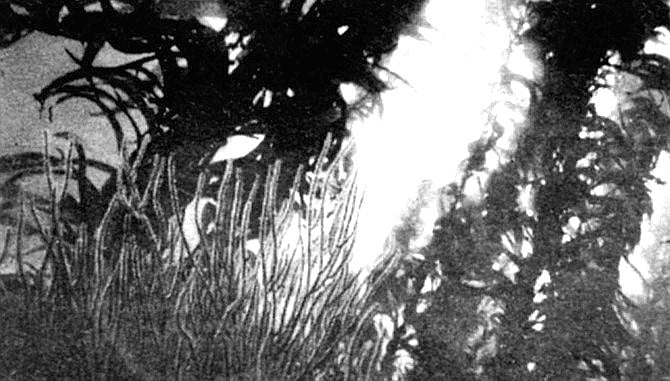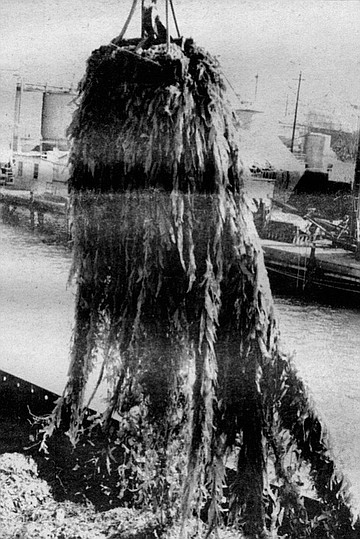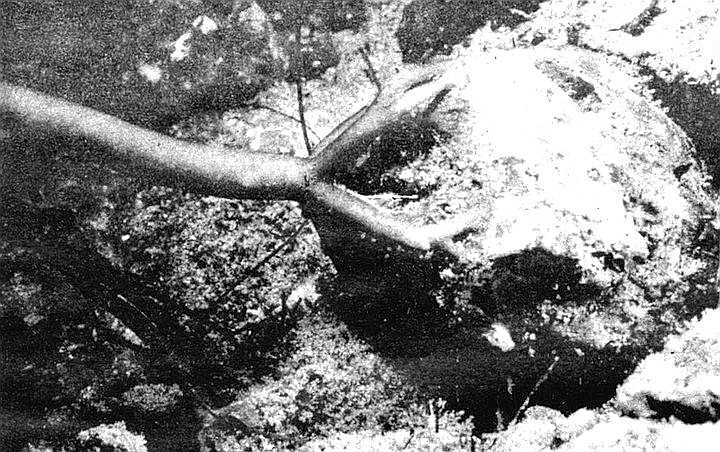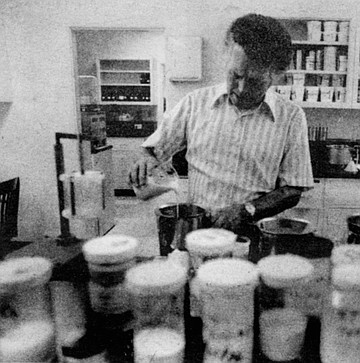 Facebook
Facebook
 X
X
 Instagram
Instagram
 TikTok
TikTok
 Youtube
Youtube

San Diego is the kelp capital of the world. For many, especially local beachgoers, boaters, fishermen, and seaside residents who are all too familiar with the long, brown, rubbery, leafy strands of kelp, this is a somewhat dubious distinction. Those who have had to untangle a fishing line, relinquish the beach to the swarms of flies attracted by unsightly, smelly piles of rotting kelp, or spend their afternoon of sailing helplessly mired in a kelp bed, would undoubtedly welcome any program to eradicate this worthless weed.

Worthless weed? “Nothing could be further from the truth,” scoffs Ron Bolen with the confidence befitting his position as the public relations director for Kelco, a multimillion-dollar San Diego company, founded in 1929, which proudly boasts of being the world's largest harvester of the infamous brown kelp.
“Go home tonight,” he continues. “Look for the more than seventy or so algin products extracted from kelp. You'll find that you’re using our product every day.”
With well-rehearsed precision, Bolen recites the many uses developed for kelp. “Most everybody knows that it is used in making ice cream. But then there are other kinds of desserts — gels, cakes, puddings, milk shakes, toppings, pie fillings. And dairy products were some of its first uses. There is salad dressing, canned foods, and all kinds of frozen foods, too. The alginates give these foods a smooth texture and a uniform consistency.

“It’s not only food,’’ he grins. “Algin is used to maintain a good head on beer; it keeps the foam from quickly collapsing.
“Oh, there is also the printing and paper industry, textile dyeing, ceramics; if it weren’t for algin, the colors wouldn’t be as bright on these products and the colors would run together. There’s paint, adhesives, car polish, cleansers, cosmetics, hand creams, and pharmaceuticals. Even products like carpets, drapes, and upholstering fabrics are coated with alginates to prevent shedding and enhance dyeing. These are really just a few.”

To the layman seaweed is seaweed, but to seaweed harvesters there is only one type of interest; macrocystis pyrifera, the giant kelp, or the "sequoias of the sea," as the weed is known in some circles. While the giant kelp beds like those off Point Loma and La Jolla are often taken for granted, there are actually very few areas in the world where the monster seaweed can grow. The ocean water temperature may be too warm, the ocean currents providing the plant with necessary nutrients may be too weak, or the ocean bottom may not be rocky enough to allow the plant to take hold. Consequently, the giant brown kelp is only found in certain spots along the Pacific coasts of Baja California, the United States, and Canada.

Once the “sequoias of the sea’’ find a suitable place to root, they are the fastest-growing plants in the world. Under optimum conditions, they can grow two or more feet in a single day. Mature plants measure up to 200 feet in length.
For an industry based on such a limited and ecologically vulnerable resource (two weeks of ocean temperatures warmer than seventy degrees would destroy an entire kelp bed), Kelco’s sprawling operations are enough to convince skeptics that there is plenty of money to be made in the seaweed business. It is one of only three companies in the world engaged in the business of commercially harvesting seaweed, and it is by far the largest producer of algin. Approximately 800 employees are involved — from sea captains and divers to physicists and chemists. Kelco owns five huge, awkward-looking ships that resemble oil tankers. Hedge-clipper knives, like large lawnmowers, are attached to conveyor belts that carry the freshly cut kelp on board. The knives trim only the top three or four feet of the weed. Each ship, after one or two days, returns with 500 tons of wet kelp, enough to make 2500 pounds of algin, which is enough to stabilize a 2,000,000-gallon milkshake.
Ron McPeak, a marine biologist, heads a team of five divers employed by Kelco to maintain the kelp beds. They weed around mature plants so the smaller plants have room to grow. They transplant and seed artificially when needed. They even have to use quicklime to combat the ocean equivalent of locusts — the lowly sea urchin, who back in the 1950s almost completely destroyed the kelp beds. The industry, dependent on adequate yields from kelp, is constantly in touch with these seaweed farmers.
“You never know what you’re going to see when you go down in the kelp beds,” McPeak says, “and I’ve been diving since 1951.”
Anyone who has had the opportunity to dive and explore the underwater forests off Point Loma and La Jolla can share McPeak’s enthusiasm for working as a seaweed farmer. Underwater the kelp forests seem green. The water has filtered out the red from the sunlight, leaving no clue that the plant is actually brown. The tail vines and leafy blades sway rhythmically with the steady, cool ocean currents; the thousands of tiny gas-filled bladders keep the huge plants upright. The only sound is the gurgling of air bubbles. It is a jungle of marine life. Kelp crabs and conical snails, all well camouflaged, graze up and down the fronds, hoping to avoid their fate as a meal for larger creatures. School after school of small fish, some red, some orange, some yellow, swim by. One even has bright blue stripes surrounding his thin red body; he looks like a barber’s pole. Larger fish, much tamer than the wild creatures in land forests, begin to approach, seemingly curious as to what species the kelp bed has attracted this time. Perch, rockfish, croakers, kelp bass, and such delicacies as abalone, rock scallops, and even the California spiny lobster have made their homes here, all looking considerably different from their well-scrubbed and manicured cousins packed in ice inside store freezers.
Although sharks and whales are always on the mind of even the most experienced diver, they are a rare sight. “It was back in 1973 at the Point Loma kelp beds,” McPeak begins, delving into his well-stocked reservoir of diving tales. “My partner and I were transplanting kelp. I had this eerie feeling that we were being watched. I turned around, looked up and saw this three- or four-inch eyeball peering down on us. The whale was no more than twelve feet away. Just lying there watching. And then, when we both turned around, he just swam off. Simply curious.”
“The shark was more exciting,” continues McPeak. “We had just been talking about white sharks, because we found the carcasses of a couple of sea otters nearby that had been attacked. As I was coming up to the boat, this big shark came swimming by within ten feet. I hid behind one of the kelp plants, whatever good that would do. It was only a basking shark. They’re the second largest in the world, but they mostly feed on the plankton.”
Seaweed farmers like Ron McPeak have more than a casual fondness for the shy sea otter. That animal will lie on his back and, using his chest, his dexterous forepaws, and a flat stone, deftly break open his tasty catch, a prickly black sea urchin. The sea otter is thus a kelp farmer’s best friend. Sea urchins have been known to devour the roots of several hundred giant kelp plants in a matter of weeks, causing the tall plant to float away and eventually rot on the beach. Before restrictions were placed on the hunting of sea otters, the sea otter-urchin-kelp ecological relationship was awry. Only in the last couple of decades has this precarious balance been restored.
“Kelp is a very limited resource,” warns McPeak. “A farmer can go purchase and plow up another forty acres. We can maybe increase a forty-acre kelp bed to forty-two, but there are simply only certain places it can grow. And there have been very bad stormy conditions the last couple of years. Kelp needs plenty of sunlight. We were really concerned there last winter during all those storms as to how it would do.”
Outside Kelco’s bayside plant under the Coronado Bridge, visitors are greeted at each of the many gates with a jumble of signs, all competing for one’s attention: Absolutely No Admittance Without Pass From Office; Danger, Underground Lines, Steam, Water, Alcohol; No Smoking Beyond This Point, Put Butts Here; Danger, Fire Lane; Danger, High Voltage Area;
Danger. Hard Hat Area; Danger, Eye Goggles Must Be Worn; No Parking; and Speed — 4% MPH.
Inside the plant, men in street clothes and yellow hard hats make their way around the complex sets of machinery and pipes that weave in and out of ladders, tall silos, steamy boilers, and ovens. At the adjoining docks, the kelp cutters unload the wet tons of decaying kelp. Later it will be cleaned, filtered, separated, chopped up, boiled, heated, dried, and processed into fine powders. Depending on the process and the chemicals extracted, the final products bear such names as Keltose, Kelvis, Keltex, Kelgin F. Kelco-Gel LV, Kelzan, Kelcoloid Do, Margel, and Keltrol F. All these items were developed at Kelco’s research laboratories, located across town in suburban Serra Mesa.
In contrast to the processing plant, the research and administrative buildings are campus-like, modem and properly landscaped. Approximately seventy men and women, clad in white lab coats, work here.
“Most people in town don't know how large we are,“ offers Pat Start, a receptionist in the main administrative office. “I'm always getting phone calls from people who want to know if we are interested in buying some kelp that they just picked up off the beach.”
Doubling as a tour guide, Start leads the way to one of the laboratories, where several staff chemists are watching a sheet full of freshly baked cookies being taken out of one of the many ovens scattered about. Gail Evans, whose long brown hair is tied in pigtails and whose blue T-shirt (the letters “KELCO” on the front) is barely visible behind her long white smock, is the first to offer a cookie.
“It’s made with seaweed,” she says with a smile. “I’m just trying to see how much seaweed to use in place of the one-half teaspoon of salt the recipe calls for.
“We usually don’t do this kind of work here,” Evans feels compelled to explain. “A lady from the Jacques Cousteau Society called us up wondering if we could find out how to make seaweed cookies. We’re just doing it as a favor. Good PR, I guess.”
The laboratory itself is a curious blend of a fully stocked kitchen — with pots, pans, ovens, stoves, and even familiar canned foods — and a more conventional research center — with microscopes, test tubes, centrifuges, flasks, and hundreds of bottles, each with its appropriate chemical insignia.
In the far comer, on a stool, sits a man painstakingly adjusting what appears to be a large drill into a familiar jar of thick, red Hunt’s Salsa Spaghetti Sauce. Another white-frocked individual nearby is working with a bag of Friskies dog food, while yet another is peering into a bowl of what looks like Jello. Pat Start, the receptionist, says, “We are always trying to get new clients by showing them that their product could be made better by using our product.”
Walking down the long, narrow hallways reminiscent of high school and college science departments. Start points to several other laboratories. The rooms, depending on their function, stock textiles, cosmetics, or large, unidentified paint cans. Other laboratories are at work on substitutes for kelp products. Xanthan gum, which was developed in these labs, is one. Kelco recently spent $34 million on another factory in Oklahoma to manufacture xanthan gum. This organism, which can be grown in com syrup, won for Kelco the coveted Food Technology Achievement Award in 1974 and has increasingly proven more versatile than the kelp products in some areas, notably, oil-drilling technology.
Forest of the Sea, a polished, eighteen-minute color film, complete with actors playing roles as Kelco employees, ends dramatically. Along the shore in Ocean Beach, an elderly actor/narrator portraying a retired Kelco sea captain, a veteran of forty years at the helm of a kelp cutter, turns his back to the camera and walks away. A young, blond surfer, emerging from the ocean, obstructs the sea captain’s departure. A surfboard under his left arm, the surfer’s right hand reaches for a strand of brown kelp clinging to his wet suit. With disdain, he throws it on the sand, and film fades to the accompaniment of a musical crescendo.
Ron Bolen turns on the lights, and while methodically rewinding the projector, he admits that he has only been in the seaweed business, as Kelco’s director of public relations, for a few months. “I was in advertising before this. Then while I was visiting San Diego a friend of mine told me about a friend of his who was an executive at Kelco. When he told me what Kelco did, I have to admit, I had some doubts.”
Today Bolen seems a veteran seaweed executive, as he lambasts “those ecological nuts who say we are raping the environment. People see our kelp cutters out there and they think we are just another company ripping off the environment. Actually, it’s in our own best interests to be conservationists and make sure nothing happens to those kelp beds.”
Like many other Kelco employees, Bolen feels that his work goes unappreciated by a public that does not understand the valuable contributions made by seaweed, the seaweed industry, and Kelco in particular. Nonetheless, even environmentalists who fully understand what Kelco does continue to voice their concern that the company is tampering with the fragile and delicate ecological relationship existing in the kelp beds. Abalone fishermen have complained that the quicklime used to kill the sea urchins has also decreased their yield of abalone. And surfers, who like the way the tall kelp smoothes their waves, curse at the kelp cutters who mow off the important top three or four feet of their ocean lawn.
Still, there are those who would relish the thought of Kelco uprooting every plant, in order to keep the 200-foot-long nuisance from blighting the beaches. These critics do not welcome the fact that, as far as Kelco is concerned, San Diego’s underwater forests are here to stay.


San Diego is the kelp capital of the world. For many, especially local beachgoers, boaters, fishermen, and seaside residents who are all too familiar with the long, brown, rubbery, leafy strands of kelp, this is a somewhat dubious distinction. Those who have had to untangle a fishing line, relinquish the beach to the swarms of flies attracted by unsightly, smelly piles of rotting kelp, or spend their afternoon of sailing helplessly mired in a kelp bed, would undoubtedly welcome any program to eradicate this worthless weed.

Worthless weed? “Nothing could be further from the truth,” scoffs Ron Bolen with the confidence befitting his position as the public relations director for Kelco, a multimillion-dollar San Diego company, founded in 1929, which proudly boasts of being the world's largest harvester of the infamous brown kelp.
“Go home tonight,” he continues. “Look for the more than seventy or so algin products extracted from kelp. You'll find that you’re using our product every day.”
With well-rehearsed precision, Bolen recites the many uses developed for kelp. “Most everybody knows that it is used in making ice cream. But then there are other kinds of desserts — gels, cakes, puddings, milk shakes, toppings, pie fillings. And dairy products were some of its first uses. There is salad dressing, canned foods, and all kinds of frozen foods, too. The alginates give these foods a smooth texture and a uniform consistency.

“It’s not only food,’’ he grins. “Algin is used to maintain a good head on beer; it keeps the foam from quickly collapsing.
“Oh, there is also the printing and paper industry, textile dyeing, ceramics; if it weren’t for algin, the colors wouldn’t be as bright on these products and the colors would run together. There’s paint, adhesives, car polish, cleansers, cosmetics, hand creams, and pharmaceuticals. Even products like carpets, drapes, and upholstering fabrics are coated with alginates to prevent shedding and enhance dyeing. These are really just a few.”

To the layman seaweed is seaweed, but to seaweed harvesters there is only one type of interest; macrocystis pyrifera, the giant kelp, or the "sequoias of the sea," as the weed is known in some circles. While the giant kelp beds like those off Point Loma and La Jolla are often taken for granted, there are actually very few areas in the world where the monster seaweed can grow. The ocean water temperature may be too warm, the ocean currents providing the plant with necessary nutrients may be too weak, or the ocean bottom may not be rocky enough to allow the plant to take hold. Consequently, the giant brown kelp is only found in certain spots along the Pacific coasts of Baja California, the United States, and Canada.

Once the “sequoias of the sea’’ find a suitable place to root, they are the fastest-growing plants in the world. Under optimum conditions, they can grow two or more feet in a single day. Mature plants measure up to 200 feet in length.
For an industry based on such a limited and ecologically vulnerable resource (two weeks of ocean temperatures warmer than seventy degrees would destroy an entire kelp bed), Kelco’s sprawling operations are enough to convince skeptics that there is plenty of money to be made in the seaweed business. It is one of only three companies in the world engaged in the business of commercially harvesting seaweed, and it is by far the largest producer of algin. Approximately 800 employees are involved — from sea captains and divers to physicists and chemists. Kelco owns five huge, awkward-looking ships that resemble oil tankers. Hedge-clipper knives, like large lawnmowers, are attached to conveyor belts that carry the freshly cut kelp on board. The knives trim only the top three or four feet of the weed. Each ship, after one or two days, returns with 500 tons of wet kelp, enough to make 2500 pounds of algin, which is enough to stabilize a 2,000,000-gallon milkshake.
Ron McPeak, a marine biologist, heads a team of five divers employed by Kelco to maintain the kelp beds. They weed around mature plants so the smaller plants have room to grow. They transplant and seed artificially when needed. They even have to use quicklime to combat the ocean equivalent of locusts — the lowly sea urchin, who back in the 1950s almost completely destroyed the kelp beds. The industry, dependent on adequate yields from kelp, is constantly in touch with these seaweed farmers.
“You never know what you’re going to see when you go down in the kelp beds,” McPeak says, “and I’ve been diving since 1951.”
Anyone who has had the opportunity to dive and explore the underwater forests off Point Loma and La Jolla can share McPeak’s enthusiasm for working as a seaweed farmer. Underwater the kelp forests seem green. The water has filtered out the red from the sunlight, leaving no clue that the plant is actually brown. The tail vines and leafy blades sway rhythmically with the steady, cool ocean currents; the thousands of tiny gas-filled bladders keep the huge plants upright. The only sound is the gurgling of air bubbles. It is a jungle of marine life. Kelp crabs and conical snails, all well camouflaged, graze up and down the fronds, hoping to avoid their fate as a meal for larger creatures. School after school of small fish, some red, some orange, some yellow, swim by. One even has bright blue stripes surrounding his thin red body; he looks like a barber’s pole. Larger fish, much tamer than the wild creatures in land forests, begin to approach, seemingly curious as to what species the kelp bed has attracted this time. Perch, rockfish, croakers, kelp bass, and such delicacies as abalone, rock scallops, and even the California spiny lobster have made their homes here, all looking considerably different from their well-scrubbed and manicured cousins packed in ice inside store freezers.
Although sharks and whales are always on the mind of even the most experienced diver, they are a rare sight. “It was back in 1973 at the Point Loma kelp beds,” McPeak begins, delving into his well-stocked reservoir of diving tales. “My partner and I were transplanting kelp. I had this eerie feeling that we were being watched. I turned around, looked up and saw this three- or four-inch eyeball peering down on us. The whale was no more than twelve feet away. Just lying there watching. And then, when we both turned around, he just swam off. Simply curious.”
“The shark was more exciting,” continues McPeak. “We had just been talking about white sharks, because we found the carcasses of a couple of sea otters nearby that had been attacked. As I was coming up to the boat, this big shark came swimming by within ten feet. I hid behind one of the kelp plants, whatever good that would do. It was only a basking shark. They’re the second largest in the world, but they mostly feed on the plankton.”
Seaweed farmers like Ron McPeak have more than a casual fondness for the shy sea otter. That animal will lie on his back and, using his chest, his dexterous forepaws, and a flat stone, deftly break open his tasty catch, a prickly black sea urchin. The sea otter is thus a kelp farmer’s best friend. Sea urchins have been known to devour the roots of several hundred giant kelp plants in a matter of weeks, causing the tall plant to float away and eventually rot on the beach. Before restrictions were placed on the hunting of sea otters, the sea otter-urchin-kelp ecological relationship was awry. Only in the last couple of decades has this precarious balance been restored.
“Kelp is a very limited resource,” warns McPeak. “A farmer can go purchase and plow up another forty acres. We can maybe increase a forty-acre kelp bed to forty-two, but there are simply only certain places it can grow. And there have been very bad stormy conditions the last couple of years. Kelp needs plenty of sunlight. We were really concerned there last winter during all those storms as to how it would do.”
Outside Kelco’s bayside plant under the Coronado Bridge, visitors are greeted at each of the many gates with a jumble of signs, all competing for one’s attention: Absolutely No Admittance Without Pass From Office; Danger, Underground Lines, Steam, Water, Alcohol; No Smoking Beyond This Point, Put Butts Here; Danger, Fire Lane; Danger, High Voltage Area;
Danger. Hard Hat Area; Danger, Eye Goggles Must Be Worn; No Parking; and Speed — 4% MPH.
Inside the plant, men in street clothes and yellow hard hats make their way around the complex sets of machinery and pipes that weave in and out of ladders, tall silos, steamy boilers, and ovens. At the adjoining docks, the kelp cutters unload the wet tons of decaying kelp. Later it will be cleaned, filtered, separated, chopped up, boiled, heated, dried, and processed into fine powders. Depending on the process and the chemicals extracted, the final products bear such names as Keltose, Kelvis, Keltex, Kelgin F. Kelco-Gel LV, Kelzan, Kelcoloid Do, Margel, and Keltrol F. All these items were developed at Kelco’s research laboratories, located across town in suburban Serra Mesa.
In contrast to the processing plant, the research and administrative buildings are campus-like, modem and properly landscaped. Approximately seventy men and women, clad in white lab coats, work here.
“Most people in town don't know how large we are,“ offers Pat Start, a receptionist in the main administrative office. “I'm always getting phone calls from people who want to know if we are interested in buying some kelp that they just picked up off the beach.”
Doubling as a tour guide, Start leads the way to one of the laboratories, where several staff chemists are watching a sheet full of freshly baked cookies being taken out of one of the many ovens scattered about. Gail Evans, whose long brown hair is tied in pigtails and whose blue T-shirt (the letters “KELCO” on the front) is barely visible behind her long white smock, is the first to offer a cookie.
“It’s made with seaweed,” she says with a smile. “I’m just trying to see how much seaweed to use in place of the one-half teaspoon of salt the recipe calls for.
“We usually don’t do this kind of work here,” Evans feels compelled to explain. “A lady from the Jacques Cousteau Society called us up wondering if we could find out how to make seaweed cookies. We’re just doing it as a favor. Good PR, I guess.”
The laboratory itself is a curious blend of a fully stocked kitchen — with pots, pans, ovens, stoves, and even familiar canned foods — and a more conventional research center — with microscopes, test tubes, centrifuges, flasks, and hundreds of bottles, each with its appropriate chemical insignia.
In the far comer, on a stool, sits a man painstakingly adjusting what appears to be a large drill into a familiar jar of thick, red Hunt’s Salsa Spaghetti Sauce. Another white-frocked individual nearby is working with a bag of Friskies dog food, while yet another is peering into a bowl of what looks like Jello. Pat Start, the receptionist, says, “We are always trying to get new clients by showing them that their product could be made better by using our product.”
Walking down the long, narrow hallways reminiscent of high school and college science departments. Start points to several other laboratories. The rooms, depending on their function, stock textiles, cosmetics, or large, unidentified paint cans. Other laboratories are at work on substitutes for kelp products. Xanthan gum, which was developed in these labs, is one. Kelco recently spent $34 million on another factory in Oklahoma to manufacture xanthan gum. This organism, which can be grown in com syrup, won for Kelco the coveted Food Technology Achievement Award in 1974 and has increasingly proven more versatile than the kelp products in some areas, notably, oil-drilling technology.
Forest of the Sea, a polished, eighteen-minute color film, complete with actors playing roles as Kelco employees, ends dramatically. Along the shore in Ocean Beach, an elderly actor/narrator portraying a retired Kelco sea captain, a veteran of forty years at the helm of a kelp cutter, turns his back to the camera and walks away. A young, blond surfer, emerging from the ocean, obstructs the sea captain’s departure. A surfboard under his left arm, the surfer’s right hand reaches for a strand of brown kelp clinging to his wet suit. With disdain, he throws it on the sand, and film fades to the accompaniment of a musical crescendo.
Ron Bolen turns on the lights, and while methodically rewinding the projector, he admits that he has only been in the seaweed business, as Kelco’s director of public relations, for a few months. “I was in advertising before this. Then while I was visiting San Diego a friend of mine told me about a friend of his who was an executive at Kelco. When he told me what Kelco did, I have to admit, I had some doubts.”
Today Bolen seems a veteran seaweed executive, as he lambasts “those ecological nuts who say we are raping the environment. People see our kelp cutters out there and they think we are just another company ripping off the environment. Actually, it’s in our own best interests to be conservationists and make sure nothing happens to those kelp beds.”
Like many other Kelco employees, Bolen feels that his work goes unappreciated by a public that does not understand the valuable contributions made by seaweed, the seaweed industry, and Kelco in particular. Nonetheless, even environmentalists who fully understand what Kelco does continue to voice their concern that the company is tampering with the fragile and delicate ecological relationship existing in the kelp beds. Abalone fishermen have complained that the quicklime used to kill the sea urchins has also decreased their yield of abalone. And surfers, who like the way the tall kelp smoothes their waves, curse at the kelp cutters who mow off the important top three or four feet of their ocean lawn.
Still, there are those who would relish the thought of Kelco uprooting every plant, in order to keep the 200-foot-long nuisance from blighting the beaches. These critics do not welcome the fact that, as far as Kelco is concerned, San Diego’s underwater forests are here to stay.
Comments